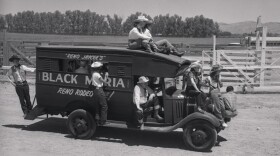While the Reno Rodeo is just in town this month, local athletes are practicing year-round. And as KUNR’s Lucia Starbuck reports, even though women have been competing in rodeos close to 70 years, their opportunities to compete remain limited.
It’s a windy day in Washoe Valley. There are several big dogs walking around, keeping a long row of lively horses company. All-around Competitor Emilie Barnes is about to practice making her way around the barrels in the dusty arena.
Barnes is a senior at the University of Nevada, Reno, majoring in veterinary science. She’s also the president of the school’s rodeo team. For Barnes, it’s a balancing act.
“It's seven days a week...24 hours. Every morning, you get up, you go outside, you do all the chores for your horses, you take care of them and you do all your own stuff," Barnes explains. "I go to school full time, I work and then come home and ride your horses, practice, night chores, feed them. And then, [at the] same time I go to the gym during the day as well, so it's kind of a constant thing,” Barnes said.
The National Intercollegiate Rodeo Association requires competitors to be enrolled in 12 credits and maintain at least a 2.0 GPA. Additionally, Barnes says her horses require training, too--a lot of it.

“I like to think that they're more of an athlete because we're not out there running the barrel patterns. I mean, we're just telling them where to go,” Barnes says. “They do more work than we do, but yeah, they’re definitely athletes.”
Barnes is an all-around competitor, which means she participates in roping events, barrel races and goat tying. She has dreams of going pro but that means she might be restricted to just barrel racing in the future, depending on where she competes.
Rodeos, including Reno’s, are organized by the Professional Rodeo Cowboy Association, but women’s events are mostly governed by the Women’s Professional Rodeo Association, known as WPRA, with barrel racing being the only all-women sport they can compete in. Men, on the other hand, have considerably more events to choose from.
The group was founded in 1948 by female ranchers in Texas who were looking to secure a place for themselves in these Western events.
“Well, at that time, most of the rodeo was all male-dominated and they felt they could bring an element to add color and femininity to the rough and tumble sport of rodeo,” said Ann Bleiker, the WPRA’s public relations director.
While many rodeos began over a century ago, women claimed their place 70 years ago and it hasn’t always been an easy transition.
“When they first started, obviously, they weren't [earning] equal money, so back in the 80's, the board of directors for the WPRA took a stand at that time that if they gave themselves a window of number of years, that if all the rodeos didn't come up with equal money for the barrel racing, that they wouldn't approve them for them to go to,” Bleiker said.
Today, the WPRA is also trying to open the door for women to participate in other events. The association has a pilot program to introduce break-away roping, an individual calf roping event for women in 35 different places. The Reno Rodeo is not one of them.
Local barrel racer, Lita Scott, has been a member of the WPRA for over 25 years. When asked if she feels like she’s treated any differently as a woman competing in rodeos, she says 'no.' But Scott’s daughter, Stevie Mae, says otherwise.
“Even in high school, I'm treated differently when it comes to roping, and when I go up and try to talk about it, I kind of get this attitude, like, I don't know what I'm talking about or I don't know what I'm doing,” Stevie Mae says. “It's totally different for roping because it is, like, a men's event where barrel racing, it’s, like, only women do it so it's their thing.”

The sport runs in the family. Scott used to barrel race for a living and is a three-time qualifier of the National Finals Rodeo. Now she’s passing her wisdom down to younger barrel racers and athletes who are part of the UNR Rodeo Team. She hopes to teach students about dedication, commitment, humility, along with how to win...and lose.
“I'd been so blessed in the industry and the sport--you have to give that back and bring people along right, and try to be an inspiration to keep the sport alive, to keep the love of the sport alive and just to help other people,” Scott said.
“For the future, I would like to continue my rodeo career and definitely move up, kind of follow in Lita’s footsteps over there and how successful she's been. She's a big inspiration to me and everybody else on the team. I definitely would like to see myself go into pro rodeo,” student Emilie Barnes said.
It seems Barnes isn’t alone. In recent years, the number of women who have joined the professional rodeo circuit has increased significantly. According to the WPRA, there were about 2,600 members in the organization in 2013. That number jumped to more than 3,000 last year, the most in the group’s history.







